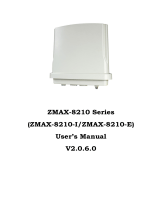
6. CPE Advanced Settings, Suitable for Point-to-multipoint
Since the Bridge devices are mainly used for long-range signal bridge and repeating, and to avoid
IP address confliction when the CPE is connected with another router device, our bridge products
disable the DHCP function (automatic IP address assignment) by default, you need configure the
CPE at the first time to use it properly.
Pls configure your PC IP as 192.168.255.xxx (XXX is a figure 2-254), and then pls connect the
CPE as the diagram below. Then power on CPE, input 192.168.255.100 at the IE bar, then input
user name and password at the user interface to enter into the configuration page.
CPE Default IP: 192. 168.255.100
Notes: The IP address of WebUI changes with the LED number
(Reference LED Number & IP Chart Setting IP)
CPE Default User Name and Password: admin/admin
6.1 How to Configure Your PC IP As 192.168.255.xxx:
a. Find the network icon in the lower right corner and click Open Network and Internet Settings.
b. Select Ethernet and Click the Change Adapter Option.
C. Find the network connection you are using and right click on Properties.
d. Double- click the IPV4 setting, select the IP address below, enter the IP and confirm.
e. Configure your PC IP as 192.168.255.xxx (xxx is a figure 2-254), note that the set PC IP
cannot be the same as the IP of the CPE.













